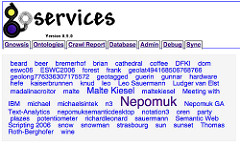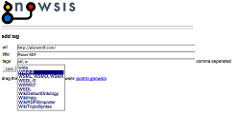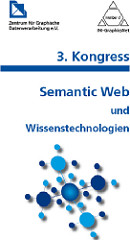At the moment we need a SPARQL conformant interface to Sesame2, and as there is none I know of, the power of open source allows us to write one.

My first question is: did somebody already write a Servlet that does map Sesame2 servers to the SPARQL protocol?
At the moment sesame2 does not support full SPARQL querying, but it will soon. We don’t have to insist on SPARQL as query language, we can pass in SERQL queries and treat them like they were SPARQL, but we have to start with a conformant servlet 🙂
Then some longer questions I also asked on the Sesame developer mailinglist:
We think that a SPARQL protocol conformant HTTP servlet is most important for any use of Sesame2 and are willing to invest 10 hours a week into this, more precisely, a clever student worker. We hope to get this done until the end of September.
We would implement a SPARQL protocol conformat query server and a SPARQL protocol conformant query client (issue tracker) for the reading operations of a HTTPSail. For updates of the model, we would stick to the current implementation of the latest CVS of sesame2.
want to know what the sparql protocol is?
I understand that these are MANY questions, I tried to think of all the calamities we are going to face in the next months. And I expect that some hackers out there already handled half of these questions, so don’t hesitate to write me, or comment here, or to the sesame devel list.
* The org.openrdf.sesame.server.http.RepositoryServlet is not conformant to the SPARQL protocol,
as defined in the WSDL, or?
http://www.w3.org/TR/rdf-sparql-protocol/#query-bindings-http
the protocol described at org.openrdf.sesame.server.http.protocol.txt does not say anything about sparql
* If not, does anybody know how to generate stubs for the servlets automatically (so that they strictly conform to the protocol)?
* If not, we would examine the Jena / Joseki implementation, as it serves as reference implementation.
* When we implement a SPARQL conformat servlet – can we put it directly into the package org.openrdf.sesame.server.http.SparqlReadServlet, directly in the latest CVS, to have the best uptake and feedback possible?
* If yes, is there also a parser for query results, that can be used on the Client side HTTP sail to read results written by the server?
* What is the status of the HTTP Client? Did anybody do since we last mailed? if yes, please add comments to this ticket:
http://www.openrdf.org/issues/browse/SES-205
* Is the query string already part of the Query object? Jeen said this is a prerequisite for this hack. If not, Jeen: could you do this? This is such a core thing that I don’t want to touch it and for you its probably only 50 lines of code.
I mean the solution 1) suggested here:
http://www.openrdf.org/issues/browse/SES-205#action_10533
* Can Sesame2 serialize Query results according to the SPARQL protocol?
I see the QueryResultFormat.SPARQL which would indicate that.
* last but not least: any news about SPARQL query support?
* Do you have a debug environment to test the existing servlets from org.openrdf.sesame.server.http?
* Does the WebClient work? (the code looks SOOO COOL! spring rocks)
– I cannot find any code in the webclient project that actually *changes* triples… hm.
* When Sebastian starts hacking, whom can he jabber/icq for help?






